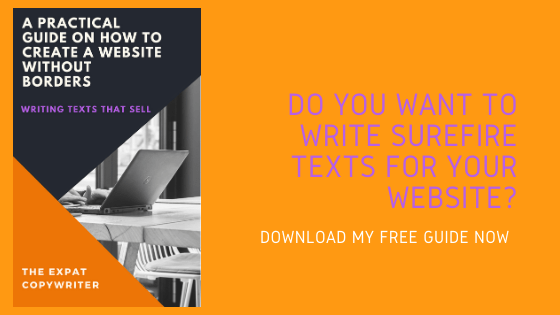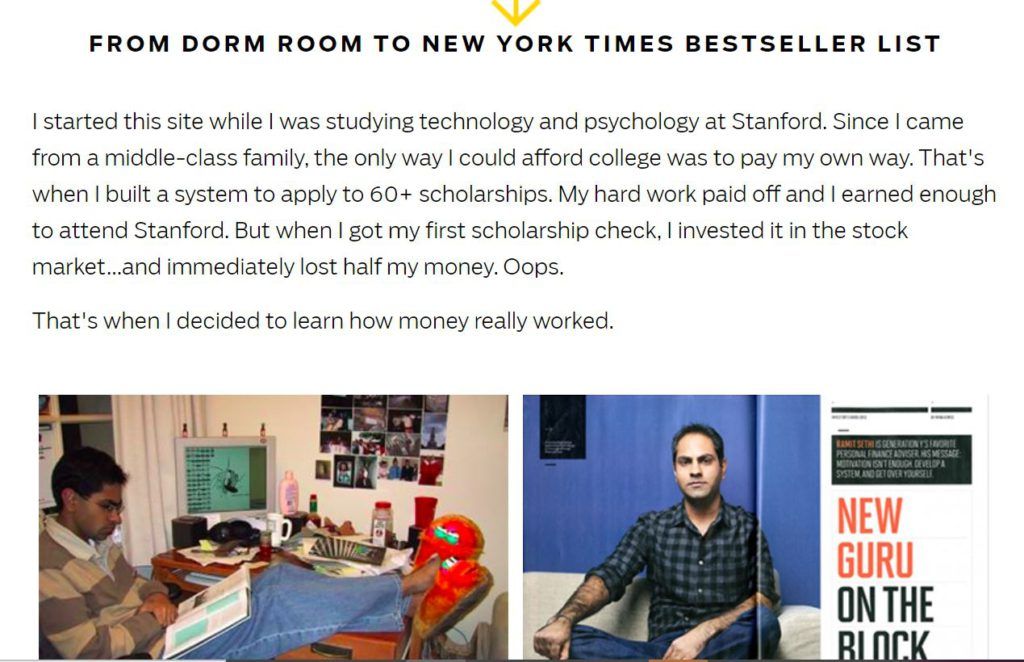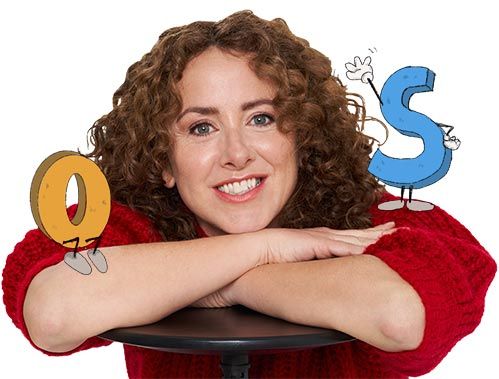Don’t worry, this happens to almost everyone, even the most experienced copywriters.
Writing about oneself is not easy.
You’re afraid of telling too much about yourself because it won’t look professional. Or on the contrary, if you tell too little you won’t engage the reader.
You also don’t want to end up sounding full of yourself or too modest and not be able to show your value.
This is precisely where the formula for a good About page lies: in mixing the personal with the professional and, above all, in being human.
The About section is one of the most important pages of your website. It’s, after the Home page, the most visited.
And not only on professionals’ websites but also on those of companies.
That’s why in this post we will focus on how to write the “About” of a company as well.
People want to hear stories.
They want to know where you come from, what makes you “you” and not someone else and why they should trust you.
So you need to put all your effort into writing a story that reflects who you are and above all how you can help the reader.
By telling your story you will differentiate your business from the competition. It’s impossible for others to have exactly the same background and experience.
There is always something that will make you stand out and bring you closer to your prospects.
So now, let’s see how you can tell your own story.
Focus on one area of your life
If you want the reader to be engaged, you should focus on a particular moment in your journey.
Think of a situation where you were blocked and didn’t know how to go on.
Or a moment of Eureka! where you had a revelation that allowed you to discover your path.
Make them feel what you felt in that moment with clear images that help them experience that same feeling.
First, decide what kind of feeling you want the reader to feel and tell a concrete example where you were sad, worried, anxious or happy so that they can feel the same.
A few days ago I explained on Instagram my turning point, that moment when I decided to quit a job that I didn’t like to dedicate my time to my passion, writing.
I wanted to encourage people who find themselves in the same situation I was to take action:
Sometimes it comes to my mind how difficult it was until I decided to quit the job I had been doing for 8 years.
For the last 2 years or so I had trouble getting up to go to work, I saw no point in anything and I was overwhelmed by the thought that I was wasting my life.
One day I hit bottom and broke down in the office. I couldn’t stop, tears ran down my cheeks, unstoppable, I cried so much that my manager had to take me aside.
I took some time off because I was in no condition to work. At that moment I was very embarrassed to admit it because I had always been a hard worker, a strong person who could handle whatever was thrown at her.
When I had time to think, I realised that I didn’t quit my job out of fear, but I was aware that staying was no longer an option.
Now I think I was very lucky to have that turning point.
I no longer see it as a sign of weakness but rather the opposite.
My body and my mind were finally grabbing me by the shoulders and telling me, “Wake up! Can’t you see this isn’t your life? What are you scared of?”
A good story has a clear goal which helps the reader to connect with you.

What was the problem you had and how did you overcome it?
People want to see the human side of the person behind your product or service.
We all feel better when we read that someone else has had a similar problem and has been able to overcome it. Having lived through a similar obstacle brings us closer together.
Be vulnerable, talk about the mistakes you made so people see you as an honest professional.
The most important is to explain how you solved the problem and what lesson you learned from it.
This way you can show in a convincing way how you can help your prospects solve that kind of problem.
Come, let’s see another example.

Nada’s Italy is a tour operator that organises private luxury tours in Italy.
Nada tells a rather difficult situation and how she got out of it and created a successful company.
Let’s look at another example of someone who also experienced a turning point.
Ramit Sethi is the author of the bestseller I will teach you to be rich. He explains on his About page the moment he decided to learn about how to be rich.

Tell your story in a way that connects with your prospects.
The lesson is what matters most
After telling your story with a concrete example, move away from the specific with a general conclusion so that the reader can connect the anecdote with a more universal truth.
If you think about it, this is the exact formula all children’s stories follow.
Do you remember the story of King Midas?
The king who was so greedy that he asked the gods for the gift of turning everything he touched into gold. The gods conceded it and so the king became super rich, something like a Donald Trump of these modern times.
But one day he accidentally touched his little daughter turning her also into a golden statue.
The king cried and cried and the gods told him:
“Greed destroys lives and separates you from your loved ones”.
In the end the gods took pity on him and gave him his little daughter back, but first he had to renounce to his power.
I’ve told you the story from memory, can you tell? 😊
Let’s see an example in real life.
I bet you’ve already heard of Marie Forleo, a life coach and celebrity. If you read my blog often then you probably have, since I’ve already talked about her website as an example several times.

The key message that Marie wants to convey is that she doesn’t agree that specialisation is the only way to succeed in life as many people advocate nowadays.
She’s always been committed to her multi-faceted profile and shows us that it’s possible.
And now let’s see an example of how you can approach your ideal customer.

Elizabeth Rider is a health coach and online business mentor. In her About Me page she makes it very clear what kind of clients her services are aimed at and tells her little story very well.
She uses phrases like:
“I’m not perfect and I definitely don’t try to be – but I do know that you can create anything you want if you’re willing to work for it.”
With these words she gets closer to her ideal customer since after researching her buyer persona’s profile, she knows what they want. Change.
Keep this in mind: your About page has 2 main goals:
– To connect and empathise with the reader
– To clarify how you can help the reader and why you are the right person/company to do so
Make sure your value proposition and unique selling proposition are crystal clear
In your About you need to include your value proposition and your unique sales proposition (USP)
But let’s first explain what exactly these 2 concepts are, since they are often mixed up.
The value proposition is what you or your product does to help the customer.
How you solve a problem or make the prospect more attractive, richer, help save time or make their life easier, which is what we ALL want.
Let’s look at an example to see it clearly.
Do you have too much junk at home?
Do you feel snowed under having less and less space?
Hello, I’m Sandra and I help you to put in order your house so that you can live in balance again.
Sandra’s value proposition is that she helps you to put your house in order. That’s clear, isn’t it?
On the other hand, the USP is what makes your business different from the competition.
It’s the answer to the prospect’s question, “why should I choose you and not someone else?”
To be able to answer this question you should carry out a research on your competition so you can figure out what makes you different.
This is the most difficult part of your About, since sometimes it’s tough to find a relevant differentiating point.
But there’s always one. It’s a matter of not stopping searching until you find it.
Think about this, it doesn’t have to be something that others don’t do or don’t have. They might do it too but they don’t talk about it.
If they don’t talk about it, prospects don’t necessarily know about it and you can stand out by talking about that skill/factor/ingredient, etc.
Let’s look at an example to see it clearly.

Joe Sugarman is one of my references in copywriting. He explains what I just told you with the iconic example of the digital watch.
He needed to sell this watch but couldn’t find anything relevant that would make it different from all the other watches.
Besides, the watch was a bit more expensive than the average and the brand was not well known.
Sugarman spent days studying the product and talking to the manufacturers.
He asked thousands of questions and wrote down the answers.
Still, he had trouble finding something relevant and interesting to differentiate that watch from the rest.
Finally, one day he spoke with one of the people at the factory and he explained that in at a certain point of the manufacturing process they used the laser to assemble some parts.
Sugarman saw in that small detail the Great Idea he was missing. This small detail of the manufacturing process would be the USP.
Bear in mind that this was back in the 1980s when lasers were still something that sounded like a science fiction movie.
Sugarman was sure this small detail would give the product an aura of modernity and high quality. And he wasn’t wrong.
The ad was a huge success and sold hundreds of thousands of watches thanks to this small detail that made all the difference.
The lesson here is that maybe other manufacturers used the laser as well to produce their watches but they didn’t talk about it.
Remember: your value proposition and USP are essential when telling your story.
About page for companies
Many companies still speak in that monotonous tone full of business jargon and paraphernalia that bores and excites no one.
It’s as if they were afraid of showing their human face and of getting a bit more personal.
But they don’t realise that showing the most human side of a company is what will differentiate it from others and what will bring them closer to prospects.
And the same happens to B2B.
After all, behind every post, web copy, marketing email, ad, document, etc. there is a person reading and not a machine without feelings or emotions.
Companies need to sell to the emotional part of the brain as every piece of copy needs to do in order to be successful.
But instead of trying to engage the reader, companies hide behind confusing and technical terms thinking it will make them look more credible and professional.
Big mistake.
Companies need to include in their About the same elements we talked about before:
– Their story
– Show empathy and write in a conversational way
– Clarify who your products and services are aimed at
– A clear value proposition and USP
Let’s look at 2 examples of how this should and shouldn’t be done.
Like this yes:

Not like this, please…
We are a leading company in the market with more than 20 years of experience. We offer customized solutions through effective processes using state-of-the-art AI technology and Big Data in the Cloud. We know what we do and we do it well, we have worked with thousands of satisfied customers.
Conclusion
Be yourself and you’ll find what sets you apart.
Tell your story or the story of your company and you will engage your prospects.
Don’t hide behind empty words and explain how you can help.
Now it’s your turn to write your own story!
Featured photo by Ian Schneider on Unsplash



0 Comments